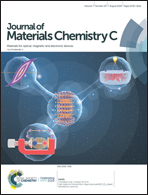High oxide ion conductivity in layer-structured Bi4Ti3O12-based ferroelectric ceramics†
Abstract
The layer-structured perovskite Bi4Ti3O12 is a well-known lead-free ferroelectric and piezoelectric material with potential applications in both non-volatile memory devices and high-temperature sensors. In this paper, high oxide ion conductivity is observed for modified Bi4Ti3O12-based ceramics, and their associated oxygen transport mechanism is investigated systemically. Impedance data and dc conductivity as a function of oxygen partial pressure reveal that Bi4Ti3O12 shows mixed oxygen ion and hole conduction. Bi deficiency in the starting composition leads to no change in the conduction mechanism and no significant increase in bulk conductivity (σb). Interestingly, high oxide ion conductivity is achieved with further Mg2+ acceptor doping at the B site. The optimum composition with a nominal formula of Bi3.88Ti2.92Mg0.08O11.74 exhibits a high σb of ∼10−2 S cm−1 and a high ionic transport number (tion) of ∼0.92 at 650 °C, which are well comparable to those of leading solid oxide electrolyte materials. Furthermore, this composition shows extremely low conductivity degradation at 450 °C, 600 °C and 700 °C. The present work opens up new horizons for Bi4Ti3O12 as an oxide ion conductor in addition to ferroelectric- and piezoelectric-based applications.



 Please wait while we load your content...
Please wait while we load your content...